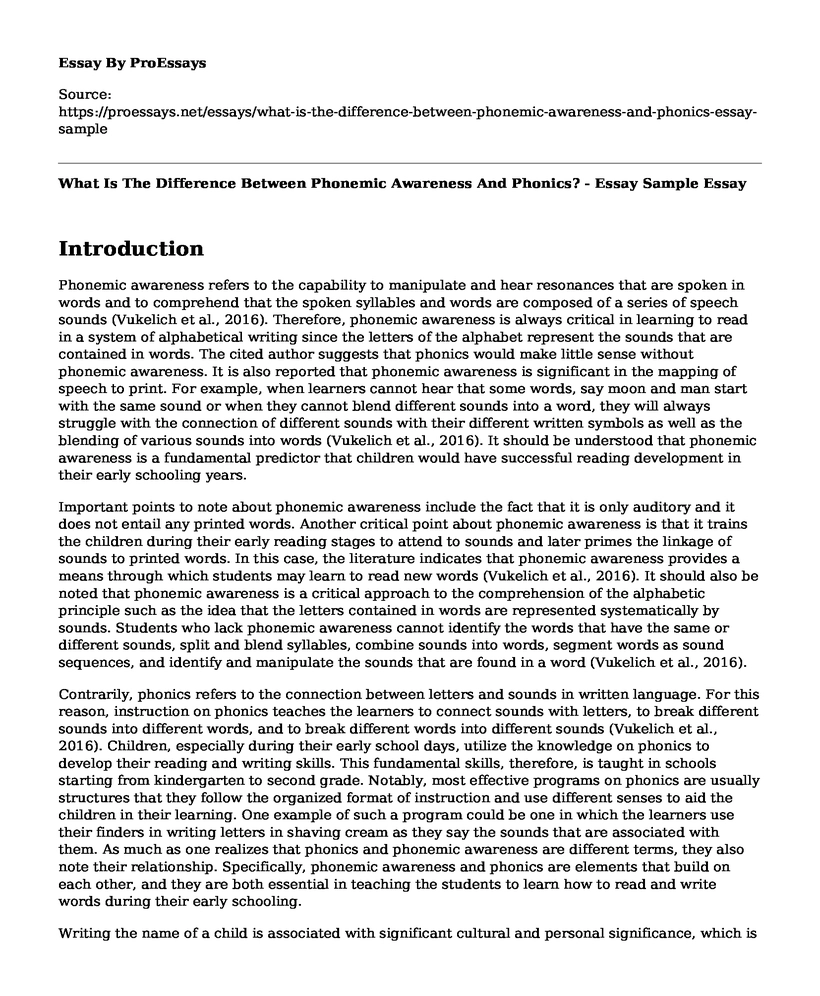Introduction
Phonemic awareness refers to the capability to manipulate and hear resonances that are spoken in words and to comprehend that the spoken syllables and words are composed of a series of speech sounds (Vukelich et al., 2016). Therefore, phonemic awareness is always critical in learning to read in a system of alphabetical writing since the letters of the alphabet represent the sounds that are contained in words. The cited author suggests that phonics would make little sense without phonemic awareness. It is also reported that phonemic awareness is significant in the mapping of speech to print. For example, when learners cannot hear that some words, say moon and man start with the same sound or when they cannot blend different sounds into a word, they will always struggle with the connection of different sounds with their different written symbols as well as the blending of various sounds into words (Vukelich et al., 2016). It should be understood that phonemic awareness is a fundamental predictor that children would have successful reading development in their early schooling years.
Important points to note about phonemic awareness include the fact that it is only auditory and it does not entail any printed words. Another critical point about phonemic awareness is that it trains the children during their early reading stages to attend to sounds and later primes the linkage of sounds to printed words. In this case, the literature indicates that phonemic awareness provides a means through which students may learn to read new words (Vukelich et al., 2016). It should also be noted that phonemic awareness is a critical approach to the comprehension of the alphabetic principle such as the idea that the letters contained in words are represented systematically by sounds. Students who lack phonemic awareness cannot identify the words that have the same or different sounds, split and blend syllables, combine sounds into words, segment words as sound sequences, and identify and manipulate the sounds that are found in a word (Vukelich et al., 2016).
Contrarily, phonics refers to the connection between letters and sounds in written language. For this reason, instruction on phonics teaches the learners to connect sounds with letters, to break different sounds into different words, and to break different words into different sounds (Vukelich et al., 2016). Children, especially during their early school days, utilize the knowledge on phonics to develop their reading and writing skills. This fundamental skills, therefore, is taught in schools starting from kindergarten to second grade. Notably, most effective programs on phonics are usually structures that they follow the organized format of instruction and use different senses to aid the children in their learning. One example of such a program could be one in which the learners use their finders in writing letters in shaving cream as they say the sounds that are associated with them. As much as one realizes that phonics and phonemic awareness are different terms, they also note their relationship. Specifically, phonemic awareness and phonics are elements that build on each other, and they are both essential in teaching the students to learn how to read and write words during their early schooling.
Writing the name of a child is associated with significant cultural and personal significance, which is why the name of a child usually acts as the first stable mode of print that is rich with meaning (Vukelich et al., 2016). At first, children will only recognize their name as a whole unit. However, the process of letter formation will always require the intervention of the adults by either teachers or parents. The attention of the child shifts to the name letters of individuals and writing them without assistance as soon as the children learn to identify their whole name. The children would then begin experimenting with the letters of their names in their pretend writing and start identifying them from their environments.
Conclusion
It is noteworthy that exploratory behavior develops the attention of the children on the details of the name letters, which causes them to exercise the motor skills associated with the formation of the name letters. In the earliest stages of learning, this activity is part of object drawing. One should note that this form of skills of early writing helps in the organization of visual analysis for print and on the strengthening of eye-to-hand motor sequences that are critical for writing print (Vukelich et al., 2016). Therefore, using children's names to teach the phonics skills provides an easy way of teaching the students to read and write. Teachers seeking to teach students how to read and write during early schooling might always want to use this approach because of its connection to the development of skills of orthographic processing that are critical in the development of rapid word recognition that facilitates early reading. This approach is also critical since research suggests that early writing is significant in the development of early literacy among the students and that it is a foundation to early reading development (Vukelich et al., 2016).
Reference
Vukelich, C., Christie, J., Enz, B., & Roskos, K. (2016). Helping young children learn language and literacy. Boston: Pearson.
Cite this page
What Is The Difference Between Phonemic Awareness And Phonics? - Essay Sample. (2022, Jun 30). Retrieved from https://proessays.net/essays/what-is-the-difference-between-phonemic-awareness-and-phonics-essay-sample
If you are the original author of this essay and no longer wish to have it published on the ProEssays website, please click below to request its removal:
- Motorcycle Man
- Argument Comparison Essay Example
- Strategies in Teaching Content Area Learning, Vocabulary, and Math
- Technology Resistance, Incompatibility, and Unpreparedness of Teachers Essay
- Explaination of Expectations About Own Work Role as Expressed in Relevant Standards
- Reflective Essay Sample on the Growth Through the Process of Learning
- College Education: A National Debate on Cost and Success - Research Paper







